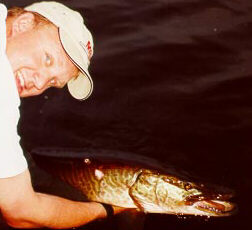|
|
Posts: 2361
| What seems to be going on as to natural reproduction there now that stocking is no longer taking place?
|
|
| |
|

Posts: 32944
Location: Rhinelander, Wisconsin | NR is historically acceptable on Pelican, but the density of the Muskie population is naturally fairly low. Before the intensive stocking program over the last decade and a half, the reputation of the lake was big fish, but not big numbers...an excellent formula for a trophy water and a bad formula for an unstocked/overharvested water. That's why Mike and Norm worked so hard to implement a 50" limit there. |
|
| |
|
Posts: 2361
| So, nobody has figured out whether the reproduction is still holding there or not? |
|
| |
|

Posts: 32944
Location: Rhinelander, Wisconsin | There's a couple more years left on the stocking moratorium before a population estimate is done again, I believe. Anecdotal evidence indicates there's NR, that's for sure. |
|
| |
|
Posts: 40
Location: Rhinelander, Wi | we have a friend who lives on the lake and said that this spring the indians speared 19 muskies out of Pelican and all of them were over 44". So that doesn't help with the natural reproduction. |
|
| |
|

Location: Lake Tomahawk, WI | boelrich2 - 7/18/2009 2:49 PM
we have a friend who lives on the lake and said that this spring the indians speared 19 muskies out of Pelican and all of them were over 44". So that doesn't help with the natural reproduction.
Correct, but still about 120 less muskies killed per year than before the 50" size limit. Hook and line anglers did a number on that lake for the last 50 years.
JS |
|
| |
|
Posts: 638
Location: Bloomington, MN | Mr. Sloan, let's not go back 50 years on any lake, but I agree Pelican has had WAY too many 34"-40" taken from it's "pristine" waters in the last 20+ years that ended up being coated in tartar sauce. The spearing has dented the population, but what has actually hurt Pelican's muskies and walleyes is the if "They" can kill one,two,three... one I can to attitude. The lake has also gone through some changes that probably has much to do with fishery. The rusty crayfish have definitely impacted the lake in a manner that may be underterminable, seepege from lake lakefront septic systems, possible introduction of invasive aquatiic plant growth. and my pet peeve is stocking strains of fish that didn't originally belong there. A majority of Pelican's larger muskies were bronze, without many markings. Due to the stockings in the late 70's/early 80's, I believe what was left of the lake's original strain is now long gone. |
|
| |
|

Posts: 32944
Location: Rhinelander, Wisconsin | I am willing to stake a strong bet the genetics on Pelican will be identical to that of the muskies from the 70's once the stocked fish life cycle out. That's exactly what happened on LCO. The lake's overall population has dropped dramatically since the stocking stopped, but we are still about a decade away from what 'might' be a two tier fishery dropping back to a low density but trophy quality destination offering big old ugly brown Muskies up to 54". |
|
| |
|
Posts: 968
Location: N.FIB | what do they do with the muskies that get speared,do they use them for food,or sell them before or after they are mounted.If they sell them,wouldn`t it be wise to inform business owners not to buy them,just wondering. |
|
| |
|

Posts: 32944
Location: Rhinelander, Wisconsin | No, the native Americans don't sell the muskies they spear. |
|
| |
|

Posts: 1996
Location: Pelican Lake/Three Lakes Chain | With the amount of undersize fish being caught the last couple of years, amount of naturally occurring tigers and shear number of fish after a ten year no stocking policy, I think Pelican can take care of its self with very limited harvest. Of course I hate to see any muskies harvested, but 19 is much more palatable than the pre-50" numbers.
As a side note, there appears to be more upper level fish availability after just 2 1/2 years of the 50" limit, but this is purely my opinion.
It is still my favorite lake to float my boat on, hopefully nothing drastic happens to change that. |
|
| |
|
Posts: 2361
| sworrall - 7/19/2009 9:37 AM
I am willing to stake a strong bet the genetics on Pelican will be identical to that of the muskies from the 70's once the stocked fish life cycle out. That's exactly what happened on LCO. The lake's overall population has dropped dramatically since the stocking stopped, but we are still about a decade away from what 'might' be a two tier fishery dropping back to a low density but trophy quality destination offering big old ugly brown Muskies up to 54".
I thought the take on LCO was that once they quit stocking, there were no muskies on that lake anymore. I think what is surprising them now is that there seems to be a remnant genetic strain similar to the earlier natives tested off mounts?
|
|
| |
|

Posts: 32944
Location: Rhinelander, Wisconsin | There are still plenty of Muskies in LCO, but it's considered 'low density' now. The genetics tested from samples from the 50's to date match identically, except for a 2 tier fishery that existed in the sampling for a generation of stocked fish...no interbreeding. |
|
| |
|
| breeding separately (no interbreeding), incompatible genetics (so no mixed offspring), or...no significant successful breeding of any kind by the stocked fish?
ie., is there any concern that the stocked fish were only present due to continued stocking and the native fish were the small population of fish that were still managing to reproduce?
obviously that would be a huge problem for the stocking program - fish that can't reproduce at a meaningful level. do you know what's being done to determine _why_ the stocked fish didn't impact the gene pool of the native fish?
|
|
| |
|

Posts: 2865
Location: Brookfield, WI | I think this stuff is pretty fascinating. Would it be possible that stocking actually slowed or harmed reproduction of native populations in some lakes? IF that was deemed to be the case, could C&R or high length limits on lakes like LCO or Pelican bring back the population in a span of ten years or so? I guess maybe what's going on on Pelican is that experiment?
Kevin |
|
| |
|

Posts: 32944
Location: Rhinelander, Wisconsin | The stocked fish did not reproduce in LCO, nor did they cause any outbreeding depression mixing with the existing population as had been claimed by some folks. Dr. Sloss discusses this in the video presentation from the Capital City MI Muskie School.
It's evident that on some water bodies including LCO, spawning habitat degradation is a major issue at hand. I don't think there's any indication the stocked fish interfered with recruitment of the original population. The experiment in place on Pelican is basically exactly that, Hopeful, especially because of the 50" limit in place there. |
|
| |
|
| http://www.dnr.state.mn.us/volunteer/julaug09/fish_science.html
This might be of interest.
Dan Crooms |
|
| |
|

Posts: 32944
Location: Rhinelander, Wisconsin | I believe Dr. Sloss's work will get us what we are looking for. Can't wait for the project to be completed. |
|
| |
|
| Yeah who in their right mind would want to follow Minnesota's example, the fishing over here sucks. 
Dan Crooms |
|
| |
|

Posts: 32944
Location: Rhinelander, Wisconsin | Minnesota has sent Dr. Sloss some samples as well.
Dr. Sloss is one of the best in his field and is highly respected. He has nearly 50 populations selected for study, and things are going well...and that study is about Wisconsin's fish based on Wisconsin's waters, which are markedly different than Minnesota's. A cross between a white crappie and a black crappie has little to do with this anyway, and we don't have Shoepac muskies here, either.
Check out the three year long 'it's the fish' debate archived in this forum...but be prepared to read for about a week.
|
|
| |
|

Posts: 714
Location: Rhinelander, WI | Since we are discussing Pelican Lake, Oneida County, WI here I am going to throw this out. We need to start preparing our troops. A small group of disgruntled fishermen who prefer to catch and keep have been pushing to overturn the 50” size limit on Pelican for the last couple of years. Well last year at the April Spring hearings they presented a resolution to go back to a 34” limit. Considering I couldn’t get enough Musky guys to stick around to the end of the meeting that resolution passed and could end up as a local question on the Congress portion of the ballet next year. The Local WDNR biologist wants the lake to stay at a 50” limit but his hands may be tied by the process. If it does show up we will need as may musky folks as possible to show up and vote this down. The limit hasn’t been in place long enough to truly prove its effectiveness, but as Norm said above people that spend a bunch of time on the water are having better luck with fish nearing that 50” mark.
I now have many more obligations (for some #*^@ reason I decided to get myself on the local school board and we are dealing with some MAJOR problems) so don’t know if I will be able to stay on top of this as I did in the past so I encourage others to remain vigilant.
Nail A Pig!
Mike |
|
| |
|
| If you read all of the artical it also talked about finding the right stain for the region which you've eluded to. Does WI still have any of these left? I know there was a big strain of brown muskies in Mille lacs, and these fish were from one 1984 stocking and thier genes were so prevelent that even today thier genetic markers are still showing up. These fish reside in Iowa. I'm just saying if we get as much info as possible maybe it's possible to fix the please all the tourist stocking that took place over there over the years.
Dan Crooms |
|
| |
|

Posts: 32944
Location: Rhinelander, Wisconsin | Short answer is yes, Wisconsin does. As I said, there is no problem indicated from the stocking at this point, we'll have to see what the final report has to say. Until that time, watch the Sloss video linked at the top of this page. |
|
| |
 Curious about Pelican?
Curious about Pelican? Curious about Pelican?
Curious about Pelican?